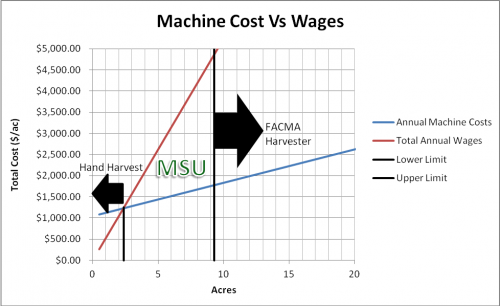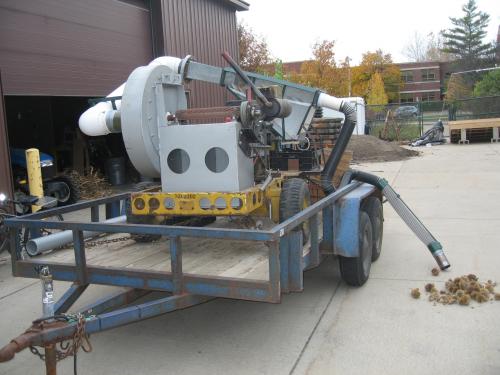Harvesting
There are many factors to consider when determining the optimal method of chestnut harvest and practices vary from hand collection, to nut wizards and even mechanized harvesters for commercial growers. As trees of cultivated chestnut orchards begin to reach significant production levels, harvest efficiency and mechanization has become critical.
Because chestnuts are not physiologically mature until they are released from their enclosing bur (when they drop to the ground) is restricted to ground pick-up. Shaking will tend to bring down immature chestnuts, which result in quality and peeling issues. Gathering chestnuts from the ground obviously presents some challenges, namely how to collect the chestnuts but not the dirt and debris from the ground.
There are both obvious and unexpected inputs into the decision equation when working toward selection of harvesting equipment for chestnuts. Below is a list of considerations when selecting a harvesting method.
1) What is my orchard size, but more importantly, at the peak of harvest, how many pounds per hour (capacity) must I be able to harvest?
- To maintain optimal nut quality, nuts must be harvested withing 48 hours of dropping and immediately placed in cold storage. Thus, at the peak of harvest you should be able to harvest half of your orchard every day. This also minimizes your loss to wildlife.
- How many hours are available for harvest each day?
2) What is the grade in the orchard? Some machines do not operate safely or as effectively on slopes.
3) What is the final market for the chestnuts (mechanically harvested nuts will not be quite as pristine as hand harvested nuts, however, after storage time this difference is seen to lessen)?
4) Human ergonomics: Some methods require one to carry/drag a large flexible hose around the orchard and bend over slightly.
5) How is the orchard pruned? Lower branches will need to be eliminated if mechanical harvest is desirable.
6) VERY IMPORTANTLY, ground preparation and ground cover. Self propelled sweeping machines are most ideally suited for firm, flat, smooth, and debris free (no excess living or cut grass and no limb pieces) ground conditions. What the brief video below for more information on preharvest orchard floor management.
7) Economics of mechanical harvest versus hand harvest ($0.30 to $0.50/lb) and labor availability for a given size orchard.
Harvest concepts and options
The following are modes or concepts of harvest. The most feasible or most appropriate method for any given operation is governed by the results of the considerations discussed above. The systems are generally listed in increasing order of complexity and cost.
1) Hand harvest (some pick-up tools/assists available such as Nut Wizard (www.nutwizard.com)). Limited by labor availability and ability to collect chestnuts in a timely fashion. Laborer must do in-field sorting/selection. Some sensitivity to ground cover.
2) Sweep (everything) in orchard with off-line secondary cleaning. Less expensive means of self-propelled harvest and relatively fast, but requires second process of separation/cleaning. Does remove debris from orchards so it is not run through harvester multiple times. Requires relatively smooth ground surface.
3) Vacuum (hose or otherwise), pick up everything, secondary cleaning. Somewhat restricted to smaller producers due to capacity of pick up and transport of nuts plus debris/burs.
4) Vacuum hose, all-area coverage, with on-board air and physical sieve sorting. Labor required to drag hose and vacuum most all material from under/around the tree. Debris is discarded. Can be PTO driven (trailer or 3-point hitch) or self powered units. Intermediate in cost.
5) Vacuum hose, following windrowing, with on-board sorting. Increases efficiency of pick up process and is more ergonomically friendly to laborers. Requires separate machines for windrowing and pick up.
6) Sweep/vacuum combination, self propelled, on-board cleaning/separation, bagging. One machine does all. Various sized/capacity machines to match to production. Requires good orchard management in pruning and ground surface preparation. Single operator or with bagging assistance labor.
7) Sweep/vacuum combination, self propelled, on-board cleaning/separation, with receiving trailer. Same as #6 above but chestnuts are collected into box trailer and only single operator is required.
Commercial machines
Most commercial chestnut harvesting machines have been developed in, and are sold in, Europe. The question remains whether these companies will open up sales to the U.S. either directly, or most likely through a distributor. The machines have been developed and refined over many years and have some unique and effective components and appear to operate well when the orchard is managed in consideration of the harvester. Below is a non exclusive list of some companies involved in chestnut harvesting machines. Most companies have a range of systems covering some of the concepts and options above.
- FACMA (Italy): Self propelled sweep/vacuum units ranging in capacity from 500 – 1700 kg/hr. Trailered PTO powered hose vacuum units ranging in capacity from 200 -900 kg/hr. Windrowers.
- Monchiero (Italy): Self propelled sweeping units and also PTO driven trailered hose vacuum units.
- Chianchia (Italy): 3-point hitch mounted hose vacuum units and various small scale electric powered cleaning stations and accessories.
- Jolly (Italy): 3-point hitch mounted mechanical sweeping and cleaning unit.
As noted, this is not an exclusive list. Additionally, the question might arise as to the potential to use harvesting machines from other nut commodities such as almonds or pecans, etc. In principle or concept some of these systems could be used, however, in those situations the nut is basically the largest object being picked up which tends to simplify the system. Limited understanding of these machines lead the author of this document to suggest modifications necessary to adapt such related crop harvesters and the inefficiencies that would remain would outweigh advantages of working with them as a system that already exists in the U.S.
Research and development
Michigan State University has been involved with looking at harvest opportunities for the growing Michigan chestnut industry. Some rough economic analysis has led to the suggestion that a void in harvesting equipment exists for “small” growers (2-8) acres who have no or minimal labor force (see figure 1), however, at this time not all commercially available systems have been observed. Our present observation is that growers with less than 2 acres can find enough local labor to conduct harvest and mechanization is likely not economically practical, while growers with greater than 8 acres should probably look at the likelihood that existing commercial systems, even though they are made in Europe, may likely be an economically feasible option. Additionally, it appears, at least for the time being, that a US manufactured system would have multiple advantages (availability, cost, repair, etc.)

Figure 1. Approximate harvest cost economics for hand versus machine harvest for $7000 machine and 3000 lb/acre production.
With this in mind, the MSU chestnut team has had conversation with the chestnut industry as to what they would currently like to see as priority in a newly/uniquely developed system. In other words should the system simply pick up everything for later cleaning; or should the system do “some” cleaning but doesn’t need to be perfect; or should the system harvest and conduct a clean sort? Clearly increased capability and capacity come at a cost. MSU has decided to attempt to maximize capability and minimize cost through development of a new concept which involves a single-stage combined vacuum and separation system involving simplicity and minimal mechanisms/components (see fig 2). Initial tests have shown the concept to have potential.

Figure 2. Single-stage chestnut harvester development prototype.
Positive aspects: Picks up and separates desirable and undesirable material; it is additionally very easy on the chestnuts. System is expected to be simple and small, possibly pulled by a small ATV or utility vehicle or mounted on a 3-point hitch.
Negative aspects: The concept/system incorporates the requirement of the need to use large vacuum hoses (as with many commercial systems).
Questions remaining: Can the components be better optimized? Does a short line manufacturer exist to move it to a commercially available system? What would be the cost of the system and can it be a feasible option?
It should be noted that some systems with similar capabilities as those being addressed by the new MSU concept, and that might have potential cost effectiveness, are commercially available from the European manufacturers with an approximate cost of purchase and delivery of around $13,000.
Additional research
MSU has acquired a FACMA self propelled chestnut harvester. The purpose of this acquisition is to conduct research on the capabilities of the machine and gain an understanding if the unit can function under existing or modified U.S. conditions. The unit was acquired such that it can be used in self propelled mode or as a simulated vacuum hose system so MSU and growers can conduct tests, demonstrations, and evaluations on efficiency, ground covers, and ergonomics. MSU is additionally conducting tests on nut quality between mechanically and hand harvested chestnuts.
Summary
Commercial harvester options exist and many questions related to economic feasibility, ergonomics, orchard size and production, and willingness to conduct proper orchard management for specific harvester types need to be considered before making a harvester purchase. MSU is positioned to help growers with these questions. Clearly with increased capability and capacity comes increased cost. MSU feels a void possibly exists in an ideal harvester for many of Michigan’s chestnut producers and is working on development of a potentially unique and cost effective system for small producers.
Disclaimer
Michigan State University does not endorse any manufacturer or type of system at this time. MSU is positioned to assist producers in understanding the operation of as well as the advantages and disadvantages of harvesting system types.



 Print
Print Email
Email